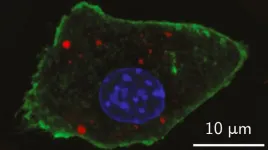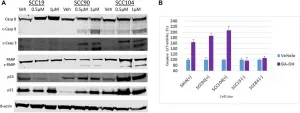Partners play pivotal role in pregnant women's alcohol use and babies' development
Rochester psychologists find successful intervention efforts need to include partners of mothers-to-be
2021-06-02
(Press-News.org) A new study by a team of University of Rochester psychologists and other researchers in the Collaborative Initiative on Fetal Alcohol Spectrum Disorders (CIFASD) finds that partners of mothers-to-be can directly influence a pregnant woman's likelihood of drinking alcohol and feeling depressed, which affects their babies' development.
The study, which appeared in Alcoholism: Clinical & Experimental Research, highlights the importance of engaging partners in intervention and prevention efforts to help pregnant women avoid drinking alcohol. A baby's prenatal alcohol exposure carries the risk of potential lifelong problems, including premature birth, delayed infant development, and fetal alcohol spectrum disorders (FASD).
"The findings emphasize how many factors influence alcohol use during pregnancy," says lead author Carson Kautz-Turnbull, a third-year graduate student in the Rochester Department of Psychology whose interests lie in FASD intervention work and reaching underserved populations, including racial minorities, rural populations, and low-income groups. "The more we learn about these factors, the more we can reduce stigma around drinking during pregnancy and help in a way that's empowering and meaningful," Kautz-Turnbull says.
The team followed 246 pregnant women at two sites in western Ukraine over time as part of CIFASD, an international consortium of researchers that researchers at the University's Mt. Hope Family Center are members of, which is funded by the NIH's National Institute of Alcohol Abuse and Alcoholism.
The team found that higher use of alcohol and tobacco by partners as well as pregnant women's lower relationship satisfaction increased the likelihood of their babies' prenatal alcohol exposure. Conversely, women who felt supported by their partners reported lower rates of depressive symptoms and were less likely to drink during pregnancy.
All study participants had a partner; most were married. In their first trimesters, the women reported on their relationship satisfaction, including frequency of quarreling, happiness with the relationship, and the ease of talking to their partners, their partners' substance use, and their socioeconomic status. In the third trimester, the participants were surveyed about their own drinking habits and depressive symptoms. Subsequently, the researchers assessed the infants' mental and psychomotor development around the age of six months.
According to the team's analysis, pregnant women's depressive symptoms and drinking directly correlated with their relationships with their partners and to their partners' substance use. (The researchers asked about alcohol and tobacco use only.) Positive partner influences resulted in women's lower alcohol use in late pregnancy and fewer depressive symptoms. The findings applied even when socioeconomic status, which is generally linked to depression and drinking, was taken into account. Higher prenatal alcohol exposure resulted in poorer mental and psychomotor development in the infants, though a mother's prenatal depression did not affect babies the way drinking did.
That's why maternal health and pregnancy interventions are likely to be more effective when partners are included, with benefits for both mothers and babies, the team concludes. Interventions addressing the partners' substance use may help reduce pregnant women's substance use, too, while improving their relationship satisfaction, protecting against depression, and boosting infant development.
Besides Kautz-Turnbull, the study was coauthored by Rochester's Christie Petrenko and Elizabeth Handley, Emory University's Claire Coles and Julie Kable, University of South Alabama's Wladimir Wertelecki, Lyubov Yevtushok of Omni-Net Centers in Ukraine, Natalya Zymak-Zakutnya of the OMNI-Net for Children International Charitable Fund in Ukraine, Christina Chambers of the University of California, San Diego, and CIFASD.
INFORMATION:
ELSE PRESS RELEASES FROM THIS DATE:
2021-06-02
Nano-sized particles have been engineered in a new way to improve detection of tumors within the body and in biopsy tissue, a research team in Sweden reports. The advance could enable identifying early stage tumors with lower doses of radiation.
In order to enhance visual contrast of living tissues, state-of-the-art imaging relies on agents such as fluorescent dyes and biomolecules. Advances in nanoparticle research have expanded the array of promising contrast agents for more targeted diagnostics, and now a research team from KTH Royal Institute of Technology has raised the bar further yet. They are combining optical and X-ray fluorescence contrast agents into a single enhancer for both modes.
Muhammet ...
2021-06-02
Researchers from Sinai Health have published a study providing an ultra-detailed look at the organization of a living human cell, providing a new tool that can help scientists around the world better understand what happens during disease.
The new study, out today in the journal END ...
2021-06-02
In the universe's earliest moments, particles existed in an unimaginably hot plasma, whose behaviour was governed by deeply complex webs of interaction between individual particles. Today, researchers can recreate these exotic conditions through high-energy collisions between heavy ions, whose products can tell us much about how hot, strongly-interacting matter behaves. Yet without extensive, highly coordinated collaborations between researchers across many different backgrounds, studies like this simply wouldn't be possible. This Topical Issue of EPJ A draws together a large collection of papers inspired by the theory of hot matter and relativistic heavy-ion collisions (THOR) European Cooperation ...
2021-06-02
The myriad processes occurring in biological cells may seem unbelievably complex at first glance. And yet, in principle, they are merely a logical succession of events, and could even be used to form digital circuits. Researchers have now developed a molecular switching circuit made of DNA, which can be used to mechanically alter gels, depending on the pH. DNA-based switching circuits could have applications in soft robotics, say the researchers in their article in Angewandte Chemie.
DNA is a long molecule that can be folded and twisted in various ways. It has a backbone and bases that stick out from the backbone and pair up with counterparts in other DNA strands. When a series of these matching pairs comes ...
2021-06-02
It's strawberry season in many parts of the U.S, and supermarkets are teeming with these fresh heart-shaped treats. Although the bright red, juicy fruit can grow almost anywhere with lots of sunlight, production in some hot, dry regions is a challenge. Now, researchers reporting in ACS' Journal of Agricultural Food and Chemistry have identified five cultivars that are best suited for this climate, which could help farmers and consumers get the most fragrant, sweetest berries.
Most strawberries commercially grown in the U.S. come from California and Florida. With the expansion of local farmer's markets and people's excitement ...
2021-06-02
Aging published "Cdkn1a transcript variant 2 is a marker of aging and cellular senescence" which reported that cellular senescence is a cell fate response characterized by a permanent cell cycle arrest driven primarily the by cell cycle inhibitor and tumor suppressor proteins p16Ink4a and p21Cip1/Waf1. In mice, the p21Cip1/Waf1 encoding locus, Cdkn1a, is known to generate two transcripts that produce identical proteins, but one of these transcript variants is poorly characterized. The authors show that the Cdkn1a transcript variant 2, but not the better-studied variant 1, is selectively elevated during natural aging across multiple mouse tissues. Importantly, mouse cells induced ...
2021-06-02
Oncotarget published "A high-content AlphaScreen™ identifies E6-specific small molecule inhibitors as potential therapeutics for HPV+ head and neck squamous cell carcinomas" which reported that the incidence of human papillomavirus-positive head and neck squamous cell carcinoma has increased dramatically over the past decades due to an increase in infection of the oral mucosa by HPV.
The etiology of HPV -HNSCC is linked to expression of the HPV oncoprotein, E6, which influences tumor formation, growth and survival.
E6 effects this oncogenic phenotype in part through inhibitory ...
2021-06-02
Oncotarget published "Molecular characterization of lung squamous cell carcinoma tumors reveals therapeutically relevant alterations" which reported that unlike lung adenocarcinoma patients, there is no FDA-approved targeted-therapy likely to benefit lung squamous cell carcinoma patients.
The authors performed survival analyses of lung squamous cell carcinoma patients harboring therapeutically relevant alterations identified by whole exome sequencing and mass spectrometry-based validation across 430 lung squamous tumors.
They report a mean of 11.6 mutations/Mb with a characteristic smoking signature along with mutations in TP53, CDKN2A, NFE2L2, FAT1, KMT2C, LRP1B, FGFR1, PTEN and PREX2 among lung squamous cell carcinoma patients of Indian descent.
In overall, the data suggests 13.5% ...
2021-06-02
When the COVID-19 pandemic arrived in North America in March 2020, health care facilities stopped providing all but "essential" care, to reduce infection risks and preserve protective gear known as PPE.
That included changes at many centers that provide ECT (electroconvulsive therapy) for severe depression and other conditions, a new survey shows.
Because ECT involves anesthesia, so that patients are unconscious when carefully controlled pulses of electricity are delivered to key areas of the brain, it is considered an 'aerosol generating' procedure. That means it poses special risks when a respiratory ...
2021-06-02
* ICFO researchers report in Nature on having achieved, for the first time, entanglement of two multimode quantum memories located in different labs separated by 10 meters, and heralded by a photon at the telecommunication wavelength.
* The scientists implemented a technique that allowed them to reach a record in the entanglement rate in a system that could be integrated into the fibre communication network, paving the way to operation over long distances.
* The results are considered a landmark for quantum communications and a major step forward in the development of quantum repeaters for the future quantum internet.
During the 90s, engineers made major advances in the telecom arena spreading out the network to distances beyond the ...
LAST 30 PRESS RELEASES:
[Press-News.org] Partners play pivotal role in pregnant women's alcohol use and babies' development
Rochester psychologists find successful intervention efforts need to include partners of mothers-to-be






